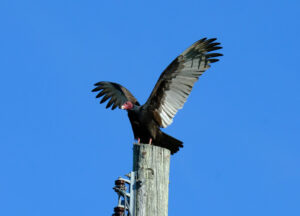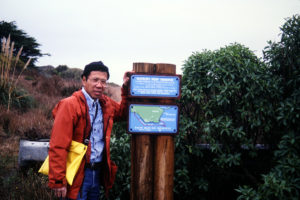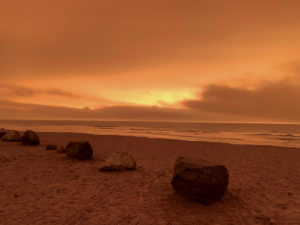If you drive up Highway One some 15 curvy miles north of the Golden Gate, through the coastal village of Stinson Beach, the view to the west opens up dramatically onto a wide-open expanse of shallow water that is one of the richest marine estuaries on the West Coast, and one of the best places around to study marine biology—Bolinas Lagoon.
It may look placid to travelers driving along the eastern edge of the lagoon. But a summer walk along the Bolinas waterfront, at the narrow western mouth of the lagoon, revealed clues to the invertebrate riches beneath the surface—namely, the scads of creatures that had converged there to exploit them.
More than a dozen great egrets were resting along the edge of Kent Island in the middle of the lagoon, waiting for the tide to recede so they could resume their feeding activities in the intertidal mudflats. Several hundred California brown pelicans, double-crested cormorants, and Western gulls crowded together on nearby sandflats. Slate-gray Heermann’s gulls patrolled the surf zone, poking their bright-red beaks into the sand and scarfing down small invertebrates. Two harbor seals stuck their heads up from the water in the channel, as several Boston Whalers returned to their moorings from fishing offshore. Meanwhile, other shore-based fishermen tried their luck from the Stinson Beach side of the channel. And just offshore, a large squadron of pelicans wheeled in the air before dive-bombing on a school of fish. In the winter, I knew, this portrait would change dramatically, with the pelicans and gulls replaced by large numbers of shorebirds and ducks arriving from the Arctic tundra and prairie potholes to the north, that either overwinter at the lagoon or stop to refuel there.
The Bolinas Wharf, located right along the channel was for years the setting for the College of Marin’s storied Bolinas Marine Laboratory (BML). For more than four decades, students from around the Bay Area studied marine life firsthand here.
Now, 18 years after being shuttered for lack of funding, and after six years of persistent advocacy and fund-raising, this unique field station is on the cusp of being reborn.
How Bolinas got its mudflats
A fortuitous combination of geology and biology makes the 1,100-acre Bolinas Lagoon such a special place. The sunken landform that forms the lagoon was created by tectonic shifts along the San Andreas Fault, which runs directly beneath it. When sea levels rose at the end of the last Ice Age some 7,000–8,000 years ago, this depression filled with water. Because of the extensive sandbar formed by ocean currents along the shoreline (now artificially—and temporarily—stabilized by the Seadrift, a development of multimillion-dollar beachfront homes built on top of it), this body of water is an estuary instead of an open bay. Through its narrow mouth separating Stinson Beach from Bolinas, the lagoon receives a twice-daily tidal infusion of nutrient-rich ocean water. Yet it remains largely protected from turbulent coastal wind and waves, by the Bolinas mesa and Duxbury Reef to the northwest, and by the sandbar to the southwest. And it also receives a modest input of fresh water from several seasonal creeks. It’s this combination of protection and nutrients that makes it so inviting to so many forms of marine life: plankton, larger invertebrates, mollusks, fish, harbor seals, wading birds, diving birds, shore birds, pelagic birds. Despite its relatively small size, Bolinas Lagoon was recognized in 2007 by the Ramsar Convention as a “wetland of international significance.”
Nearby Duxbury Reef is another gem—the largest rocky reef on the West Coast of the United States, and the largest shale reef in North America. Due in part to the plankton that grows in the nutrient-rich waters of the lagoon, intertidal life is particularly abundant on the reef.
A laboratory’s origins
In the late 1950s, the College of Marin, a public community college, purchased the buildings of the recently deactivated Coast Guard Station on the Bolinas Wharf. By 1964, the Bolinas Marine Lab opened, thanks in large part to the efforts of marine biology instructors Al Molina and Gordon Chan. It became a renowned, storied field station over the next 41 years. Hundreds of students learned about the coastal environment by doing fieldwork at the lagoon and the reef, and thousands visited it.
Many of the students who passed through Molina’s and Chan’s classes and got their start at the lab went on to work in the natural and environmental sciences, including Terry Gosliner, now senior curator of invertebrate zoology and geology at the California Academy of Sciences; Lynne Stenzel, marine ecologist and research associate at Point Blue Conservation Science; and Joe Mueller—the current marine biology instructor at the College of Marin, who would eventually also become the chief cheerleader for the lab’s revival.



For years, Marin College students learned about marine biology by taking samples from the lagoon and reef back to Bolinas Marine Laboratory. After the lab was shut down for lack of funding, instructor Joe Mueller started teaching—out of the back of his Honda Accord. (Archive photos courtesy of Joe Mueller)
The Honda Accord years
Following the untimely deaths of Molina and Chan in the 1990s, Mueller took up the role of chief instructor at the BML, teaching classes there from 1995 to 2005. Students loved them. But the program’s popularity wasn’t matched by investments in the old Coast Guard buildings, built in 1918, that housed the lab. This funding shortfall was in large part the result of voters’ passage of Proposition 13 in 1978, which drastically reduced taxpayer support for the community college system. The water pumping system, which supplied salt water from the lagoon to the lab’s wet tables—where students could study organisms they found in the lagoon or on the reef—was the first critical piece of infrastructure to go, though the building continued to be used for on-site lectures. Then, lacking funding for upkeep, in 2005 the buildings were deemed unsafe for occupation, particularly given their location on the edge of an active earthquake fault. With that, the facility—only one of two of its kind in the state’s community college system—was closed.
For the next 12 years, Mueller continued to teach marine biology field classes, but in less than ideal conditions. When people asked him how he did it, he would show them photos of nets and scopes stored in the trunk of his Honda Accord. “The lab was in the back of my car,” he told me. “We’d find picnic tables next to tidepools, and set up there.” Yet, all the while, Mueller and others—teachers, former students, Bolinas residents among them—kept the dream of reopening the lab alive. By 2017 the idea had at last gained traction in the broader community—and, crucially, with the college’s administrators and trustees, who launched a capital fundraising campaign to support the initiative.
A dream kept alive, and updated for a new age
Mueller was fond of telling anyone who would listen that there are three salient reasons for resuscitating the Bolinas Marine Lab: “Location, location, location.” Apart from the lagoon’s fortuitous biology and geology (and its proximity to the San Francisco metro area), it’s also close to a remarkable range of protected coastal areas. With Mount Tamalpais, the Golden Gate National Recreation Area, and Rodeo Lagoon to the south, and Point Reyes National Seashore, Drakes Estero, and Tomales Bay directly to the north, educators can expose students to a mosaic of habitats to compare their similarities and differences.


In 2005, the marine lab’s facilities were deemed unsafe and closed down. (Archive photos courtesy of Joe Mueller)
In the next incarnation of the Bolinas Marine Lab, the College of Marin aims to boost equity and inclusion. “It’s an incredible opportunity for students to get involved in marine science at a high level—at an actual laboratory—which is something usually only available to students at a well-resourced four-year university,” Mueller says. It opens the door to the marine sciences, specifically, for students in the low-cost community college system, many of whom have limited resources or are people of color (and underrepresented in those fields).
As part of this effort, the college is teaming up with another venerable Bolinas Lagoon institution, the Martin Griffin Preserve of Audubon Canyon Ranch (ACR). ACR runs an active education program for grade-school and high-school kids from around the Bay Area, including many from city schools. The preserve, which lies next to the lagoon’s eastern shore, has an overnight facility at Volunteer Canyon where students can stay. Education director Catie Clune says that “collaborating with the BML will allow ACR to expand its educational programming. Students will have an incredible opportunity to experience a microcosm of Northern California’s coastal ecosystem, from the forested ridgeline above the canyon all the way down to the ocean.”
Clune hopes that by enabling younger students to make observations in the field, “as well as going beyond the usual ‘make-work’ assignments to participate in real-world research projects at a state-of-the-art laboratory,” this collaboration will encourage more of them to consider pursuing careers in natural sciences.
“Nature sells itself,” Mueller says. “Give inner-city kids the opportunity to touch a sea cucumber, and you’re on your way to inspiring the region’s next generation of marine scientists.”
A lagoon in flux, worthy of study
Mueller hopes, too, that the lab will serve as an important locus for studying the impact of climate change on the California coast. The lagoon is always evolving and morphing in complex ways. Sedimentation from the land (accelerated by increasingly strong atmospheric river storms fueled by climate change) competes with sea level rise (thanks again to climate change) to shape and alter the arrangement and persistence of habitats within the lagoon. Meanwhile, there’s a constant interplay between sand washing into the lagoon from the ocean and sediment washing down from the surrounding hills.
How such dynamism affects the microscopic and benthic organisms that form the base of the food web in the lagoon is something scientists are interested in better understanding. Higher up the food chain, the lagoon’s winter bird populations have been counted and studied for over 40 years by researchers from Point Blue Conservation Science (formerly Point Reyes Bird Observatory) from its nearby Bolinas field station. Led by Lynne Stenzel, the researchers have documented a significant drop in the number of shorebirds overwintering in the lagoon.
Their conclusions point to factors beyond the the lagoon’s bathymetry as the major drivers for that drop. And one may not be a sad story, actually. In particular, they point to the extensive work to restore wetlands in the Sacramento Valley and in San Francisco Bay as a major factor. Those wetlands are now attracting migratory birds, giving them larger options for foraging than Bolinas’s relatively small lagoon.

Back in 1973, Marin County created the Bolinas Lagoon Advisory Council to track environmental changes in the lagoon and make scientifically informed recommendations to policy makers. As council reports have noted, the movement of sediment has created more high-intertidal and salt marsh habitats, while some subtidal and low-intertidal habitats have disappeared. This has led to some speculation that the lagoon could eventually fill in or lose its connection to the ocean. But scientific consultants ESA Associates, in a 2016 report, calculated that the tidal prism—that is, the volume of water coming into the lagoon from the ocean—will likely outpace the rate of sedimentation and keep the inlet open and active into the foreseeable future, particularly as the sea level rises.
These and other scientific reports provide an invaluable baseline for students to continue documenting future changes in the lagoon. In addition, Mueller was able to rescue from the condemned lab building several large boxes containing four decades of student-generated datasets and research papers on the lagoon and Duxbury Reef. He hopes to digitize the data to help jumpstart future student research on changes that have already occurred and those coming down the pike.
How it all came together
At last, a new laboratory is in sight.
By the summer of 2021, sufficient funds had been raised to demolish the old structures and to begin drawing up plans for a new modern marine biology research and teaching facility. In the spring of 2023, the plans were put out to bid, and a ceremonial ground-breaking ceremony at the now-vacant fenced-off site along the wharf was held in late July. A grant of $1 million in the state’s 2023-24 budget has allowed the College of Marin to reach its goal of $6 million for construction costs, while fundraising continues to support the purchase of equipment for the lab itself. The goal is to open the lab to classes beginning in the spring semester of 2025.
Mueller, who has been eyeing retirement, hopes to stick around long enough to be able to teach a few classes in the brand-new facility, and then pass the torch to a new generation of scientist—who will, among the pelicans and the cormorants, the seals and the fishermen, take up the challenge of tracking the dynamic mosaic of marine life and habitats at this accessible gathering place for wildlife, people, and tectonic plates at the western edge of the Bay Area.





